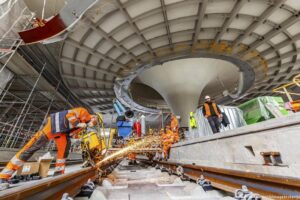
(function(w,q){w[q]=w[q]||[];w[q].push([“_mgc.load”])})(window,”_mgq”);
Ukraine’s state railway operator Ukrzaliznytsia has signed a strategic contract with French manufacturer Alstom to supply 55 modern electric freight locomotives worth roughly €470–473 million, in a deal financed largely by international development banks and signed in Paris on 17 November 2025 in the presence of Presidents Volodymyr Zelenskyy and Emmanuel Macron.
The agreement on French-built locomotives for Ukraine aims to stop the rail system from hitting a “traction wall” within just a few years, replacing a war-battered locomotive fleet that averages 46 years in age while keeping export corridors open and accelerating the shift from Soviet-era infrastructure toward a more integrated European network.
What the new locomotives will do
According to Alstom and Ukrainian Railways, the order covers 55 Traxx Hauler dual-voltage electric freight locomotives designed for Ukraine’s 3kV DC and 25kV AC power systems.
Key facts about the contract
Quantity: 55 Traxx Hauler freight locomotives
Total value: about €473 million, with Ukraine citing a 37% cost reduction thanks to grant funding
Financing mix: roughly €173 million in grants from the World Bank’s URTF fund and a €300 million long-term loan from the European Bank for Reconstruction and Development (EBRD)
Production site: Alstom’s plant in Belfort, France
Delivery timeline: first locomotive in Q1 2027, full batch delivered between 2027 and 2029
Capability: power output of 7.2–9.4 MW, maximum speed of 120 km/h, Bo-Bo configuration with each axle powered individually, and Ukrainian-made safety and radio systems onboard
Henri Poupart-Lafarge, Alstom’s chief executive, called the contract “a significant milestone in our commitment to supporting the modernisation of rail transport in Ukraine,” stressing that the locomotives are tailored to the country’s infrastructure while boosting energy efficiency and reliability.
On the Ukrainian side, the new fleet is expected to replace roughly 80 of the oldest locomotives and cut operating costs by more than 30%, giving Ukrzaliznytsia more traction power with fewer vehicles and lower energy and maintenance bills.
Why Ukraine’s railways need new traction now
In its announcement on the official Ukrzaliznytsia website, the company describes a stark starting point: the average age of its locomotive fleet is 46 years, with overall wear exceeding 96%. Without rapid renewal, managers warn that in 2–3 years the traction deficit would become so severe that the railway could no longer move the volumes needed to sustain Ukraine’s export-driven economy, costing up to 10% of freight revenue every year.
That risk comes on top of passenger-side shortages. A recent in-depth look at Ukraine’s rail sector describes how wartime losses have left Ukrzaliznytsia with about 500 fewer passenger cars than in 2022, after at least 150 cars were written off in a single year, cutting daily capacity by thousands of seats even as demand stays high. Chronic ticket shortages are compounded by frozen, state-controlled fares and long-standing governance problems that make it hard to finance new rolling stock from operations alone.
At the same time, the railway has had to carry more with less. Company data show that in 2023 Ukrzaliznytsia transported around 25 million long-distance passengers, including about 2 million to EU countries, and boosted freight volumes by roughly a third compared to the first year of the full-scale invasion. The new electric locomotives are meant to lock in that performance before the aging fleet and wartime damage start forcing hard cuts.
Financing and industrial diplomacy behind the deal
Ukrzaliznytsia says the locomotives were procured through a World Bank international tender that drew interest from more than ten rolling-stock manufacturers from Europe and Asia, with Alstom Transport S.A. submitting the winning compliant bid. Independent technical and procurement consultants assessed the offers and concluded that the price per axle and kilowatt of traction power for the dual-system locomotives was competitive for this segment, especially once grant money is factored in.
The financing is structured to ease pressure on a company already struggling with war-time debt and collapsing freight volumes. Reuters has reported that Ukrzaliznytsia’s freight traffic has dropped by nearly half since 2022, with management warning of a possible 30-billion-hryvnia bailout need in 2026 unless tariffs rise and new revenue streams appear. In this context, a package where more than a third of the cost is non-repayable grant funding is politically and fiscally attractive.
The contract also doubles as a long-term industrial partnership. Under the terms described by Ukrzaliznytsia, the locomotives themselves will be built in France due to time and financing constraints, but both sides have agreed to explore integrating Ukrainian suppliers over the full service life of the fleet.
That includes potential local production of safety systems, communications equipment, brake pads, wheelsets, cabling and cooling systems, with a large matchmaking meeting between Alstom, Ukrzaliznytsia and domestic manufacturers planned for early 2026.
A modern service center for the new locomotives is also set to be created on the basis of an existing Ukrzaliznytsia facility in Ukraine, anchoring high-tech maintenance work and skilled jobs inside the country rather than outsourcing them to EU depots.
Railways under fire but still moving a country at war
The deal lands as Russia intensifies strikes on Ukraine’s rail network. According to Oleksii Kuleba, a deputy prime minister with responsibility for infrastructure, there have been more than 800 railway-related attacks on the network since the beginning of 2025, damaging over 3,000 facilities and causing about $1 billion in losses. Precision drone and missile strikes now deliberately aim for locomotives and traction infrastructure, trying to cripple the system that moves troops, Western weapons, grain and civilians.
Yet the railway keeps running. In recent weeks, Ukrzaliznytsia has described how, after blackouts and missile strikes in regions like Dnipropetrovsk and Kharkiv, damaged trains and infrastructure were patched up quickly, reserve diesel locomotives were deployed, and long-distance trains rerouted over bypass lines to ensure that passengers still reached their destinations—often with only hour-scale delays.
The company is also redesigning schedules and depot patterns to reduce how long trains and crews spend in the highest-risk areas, explicitly trying to stay one step ahead of Russia’s targeting patterns. The new electric locomotives are expected to slot into this doctrine: higher power and better reliability should let Ukrzaliznytsia haul longer and heavier freight trains in fewer slots, making each safe corridor or window of intact infrastructure go further.
The locomotive order is not happening in isolation. Ukraine has already opened its first European-gauge railway between Uzhhorod and Chop, co-financed by EU instruments and designed to connect directly with neighboring EU states. Together, these projects signal a shift from merely repairing Soviet-gauge legacy infrastructure to gradually building an EU-integrated rail system even while the war continues.
What comes next
If everything stays on schedule, the first Traxx Hauler locomotive should arrive in Ukraine in early 2027, undergo certification and testing on Ukrainian tracks, and then enter regular freight service later that year. The full fleet would be in operation by 2029, overlapping with ongoing reconstruction of war-damaged infrastructure.
By that time, Ukrzaliznytsia is likely still to face many of the structural questions highlighted earlier—from governance and debt to tariff policy—which will shape how effectively it can use the new assets. In a railway system that has become a lifeline for Ukraine’s defense, economy and “iron diplomacy” with foreign leaders, securing modern locomotives may be one of the preconditions for longer-term success, while taking into account its wartime resilience.
Read also
Ukraine just built a European-gauge railway during the war
Ukraine’s railway crisis threatens EU reconstruction investments
(function(w,q){w[q]=w[q]||[];w[q].push([“_mgc.load”])})(window,”_mgq”);





